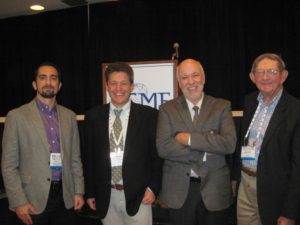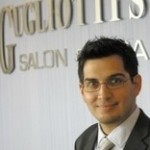Dr. Morad Behandinsh and Professor Horea Ilies won two consecutive Best Paper Awards at the 2014 and 2015 Computers and Information in Engineering (CIE), which is part of the annual international ASME IDETC & CIE Conferences. Their papers, titled “Peg in Hole Revisited: A Generic Force Model for Haptic Assembly,” and “Haptic Assembly Using Skeletal Densities and Fourier Transforms” were selected among the 143 and 130 papers, respectively, presented at the two CIE conferences.
The state-of-the-art in haptic-assisted virtual assembly is based on a distinction between two modes of function, namely, a free motion mode implemented with collision detection engines, and an insertion mode during which the software assists the user in the precision assembly task by providing geometric virtual constraints. The identification of the switch criteria between the two modes has been one of the open problems in virtual assembly of complex objects. The two UConn researchers have developed a novel technique to automatically detect the geometric constraints for assembly guidance using a generic force model that applies to objects of arbitrary shape. They showed that their approach creates the attraction forces and torques towards the assembly configuration corresponding to proper alignment as well as the repulsion forces and torques in case of collisions. Their work, supported by National Science Foundation, is the first one to unify the free motion and insertion modes during virtual assembly into a single functional mode for shapes of arbitrary complexity.
A(n Academic) Family Business
During the 2014 conference, the organizers of the flagship international event on Design Engineering, which is the ASME IDETC & CIE Conference, honored two other awardees that are closely connected to the UConn researchers.

Vadim Shapiro, the Bernard and Frances Weideman Professor of Mechanical Engineering and Computer Science at the University of Wisconsin received the Design Automation award for his outstanding contributions to geometric and physical modeling. Herb Voelcker, the Charles Lake Professor of Mechanical Engineering Emeritus at Cornell University received the CIE Lifetime Achievement Award to “recognize a person who has had a significant impact on the use of computers in engineering practice and/or education.” Shapiro is Ilies’ academic PhD advisor, and Voelcker is his academic grandfather, which makes the 3 different prizes awarded concurrently to this academic family for independently conducted research an extraordinary experience.


 Martin Gugliotti (B.S. Mechanical Engineering/Materials Engineering, ‘01) was named one of 42 winners of the 2014 Hartford Business Journal
Martin Gugliotti (B.S. Mechanical Engineering/Materials Engineering, ‘01) was named one of 42 winners of the 2014 Hartford Business Journal 
